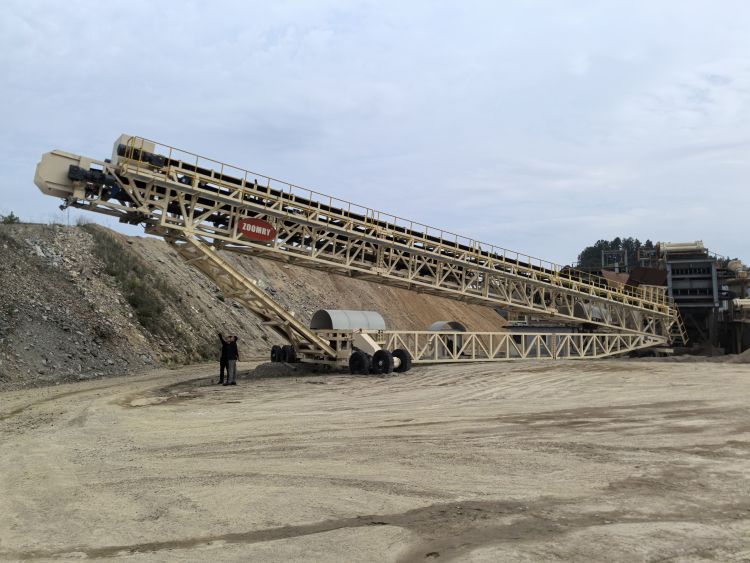In the field of bulk material handling, truck unloaders/Feeders and Radial Telescopic stackers are two core pieces of equipment with distinct functions. As a professional manufacturer with over 20 years of experience in bulk material handling solutions, Zoomry Heavy Industry provides an in-depth analysis of their technical differences and application scenarios to help global customers make precise selections.

Core Functional Differences
Truck Unloader
The primary task is to efficiently transfer bulk materials from transport vehicles to downstream systems. Serving as the "starting point" of material handling, it receives materials such as ores, coal, or grains dumped by trucks into a low-level hopper, then transfers them via an internal conveyor to designated locations (e.g., storage silos, downstream conveyors, or stackers).
Radial Stacker
The primary task is to efficiently and flexibly store bulk materials. Acting as a "transfer or endpoint" in material handling, it receives materials from upstream systems (e.g., unloaders or main conveyor lines) and, through its unique radial rotation, boom telescoping, and luffing functions, forms organized, high-capacity stockpiles in designated areas.
Structural and Design Differences
Receiving Unit
- Truck Unloader: Features a low-level, wide-mouth hopper. The design focuses on maximizing the receiving width—for example, Zoomry's truck unloaders offer customizable openings ranging from 3.5m to 5.7m and reduced approach angles (typically 12.1%/6.7 degrees) to accommodate various trucks, loaders, or excavators. The hopper often includes a grizzly screen to filter oversized debris.
- Radial Stacker: Centers on a conveyor boom system. Equipped with a standard or customized feed hopper (usually 10m³ as standard), it is positioned at a higher level to receive material flow from upstream conveyors, with specific height requirements.
Mobility and Chassis
- Truck Unloader: Moves less frequently, mainly to adjust stockpile positions. Zoomry employs heavy-duty steel truss chassis with optional tire or track drives. The chassis features hydraulic lifting for switching between transport and operational modes, ensuring stability during radial rotation.
- Radial Stacker: Requires frequent repositioning to adapt to different truck unloading points. Zoomry offers heavy-duty tire-mounted or all-terrain track-driven chassis with hydraulic outriggers for stability, prioritizing mobility and ground adaptability.
Core Working Mechanism:
- Truck Unloader: Equipped with a fixed or short-range telescopic conveyor. Its main function is to elevate and transfer materials from the hopper to downstream equipment (e.g., stackers or main conveyors), with relatively fixed length and discharge height.
Radial Stacker
- Radial Rotation: The boom rotates around a central point (typically ≥270°) for circular or sector stockpile coverage.
- Boom Telescoping: The inner conveyor extends within the boom (Zoomry's ZR-SF series offers 10-22m telescopic range), adjusting discharge points to minimize relocation.
- Boom Luffing: Adjusts the boom angle to control stockpile height, optimizing shape and capacity (Zoomry's max tilt angle: 18°).
- Smart Control: Includes PLC auto-stacking systems and HMI interfaces for unmanned operation and minimized material segregation/degradation.
Application Scenarios and Target Clients
Truck Unloader Applications:
- Mines/Quarries: Rapid unloading of ore trucks.
- Ports/Terminals: Transferring truck materials to stockyards or ship loaders.
- Power Plants/Cement Plants: Receiving fuel (coal) or raw material trucks.
- Large Infrastructure Projects: Efficient handling of aggregate unloading.
Radial Stacker Applications:
- Bulk Storage Yards: Large-scale storage of coal, iron ore, grains, wood chips, etc.
- Pre-Shipment Port Buffers: Providing stockpiles for ship loaders.
- Mine Processing Plants: Intermediate storage of raw or concentrated ores.
- Mixing Plants/Asphalt Facilities: Aggregate storage and batching.
Key Performance Comparison (Zoomry Models)
| Feature | Truck Unloader (ZRLS-TU1800) | Radial Stacker (ZR120SF) |
|---|---|---|
| Primary Function | Truck unloading & material transfer | Automated stacking & storage management |
| Max Capacity | 600-1800 t/h | 1500 t/h |
| Mobility | Heavy-duty tires / All-terrain tracks | Tires / Tracks (with hydraulic lift) |
| Core Movement | Fixed/short-range conveyor | Radial rotation + Boom telescoping + Luffing |
| Control System | Basic remote / Local control | Full PLC automation + HMI + Remote |
| Stockpile Height/Capacity | N/A | Up to 20m, +28% capacity increase |
| Typical Clients | Mine fleets, port logistics, raw material receivers | Stockyard operators, ports, large mines/plants |
How to Choose Between Them
- Define Core Needs: Is it "material intake" (unloader) or "storage management" (stacker)? They often work in tandem.
- Assess Material Properties: Particle size, moisture, and abrasiveness influence hopper design (unloader) or anti-segregation measures (stacker). Zoomry offers customized solutions.
- Evaluate Site Conditions: Flat terrain suits wheeled unloaders (e.g., Zoomry's track models) or compact stackers; rugged terrain favors track chassis (both available). Determine stacker rotation angle, telescopic range, and height requirements.
- Consider Automation: Stackers (especially Zoomry's models) with PLC automation significantly reduce labor costs and material loss. Unloaders typically require operator coordination.
- Plan System Integration: Both are key links in bulk handling systems (e.g., Zoomry's EPC solutions), requiring seamless coordination with upstream/downstream equipment (e.g., main conveyors, ship loaders).
Truck unloaders serve as high-efficiency entry points for bulk handling, while radial stackers are core tools for intelligent storage and management. Zoomry Heavy Industry, certified internationally (CE/EAC/KCS) and equipped with proprietary components (high-performance idlers, drums) and EPC expertise, delivers lifecycle solutions for mining, ports, power, and construction sectors. Understanding their differences and selecting based on specific needs maximizes ROI and operational efficiency. "We Move the World"—Zoomry powers global industry.

 ZOOMRY
ZOOMRY

